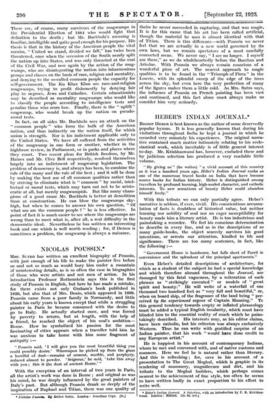NICOLAS POUSSIN.*
Mits. SUTRO has written an excellent biography of Poussin, with just enough of his life to make the painter live before us and not so much as would bury him under a mountain of uninteresting details, as is so often the case in biographies of those who were artists and not men of action. In his introduction Professor Rothenstein says this is the first study of Poussin in English, but here he has made a mistake, for there exists not only Graham's book published in 1820, but also that of Mrs. Denio, which appeared in 1899. Poussin came from a poor family. in Normandy, and little about his early years is known except that while a struggling painter in Paris he became consumed with the desire to go to Italy. He actually started once, and was forced by poverty to return, but at length, with the help of a friend, he reached the object of his soul's ambition—. Rome. How he symbolized his passion for the most fascinating of cities appears when a traveller told him he was anxious to take home with him some fragment of antiquity ;— " Poussin said, ' I will give you the most beautiful thing you could possibly desire.' Whereupon he picked up from the grass a handful of dust—remains of cement, marble, and porphyry, reduced almost to powder. Seigneur,' he said, take this away with you ; this is the dust of ancient Rome.' " With the exception of an interval of two years in Paris, all the artist's work was done in Romc ; and original as was his mind, he was deeply influenced by the great painters of Italy's past. But although Poussin drank so deeply of the inspiration of Raphael and Titian, there was one quality of • Fichelas l'oussiss. By Esther Batty. London : Jonathan (hpe. Os./ theirs he never succeeded in capturing, and that was magic. It is for this cause that his art has been called artificial, though the material he uses is almost identical with that of Titian. There is this difference—with Poussin we never feel that we are actually in a new world governed by its own laws, but we remain spectators of a most carefully concocted scene. We never say, " I see no longer. I myself am there," as we do wholeheartedly before the Bacchus and Ariadne. With Poussin we always remain conscious of a wonderful piece of art. The nearest approach to magic qualities is to be found in the " Triumph of Flora " in the Louvre, with its splendid sweep of the edge of the trees across the sky, but even here the very perfection of many of the figures makes them a little cold. As Mrs. Sutro says, the influence of Poussin on French painting has been vast and continued, and this fact alone must always make us consider him very seriously.






































 Previous page
Previous page